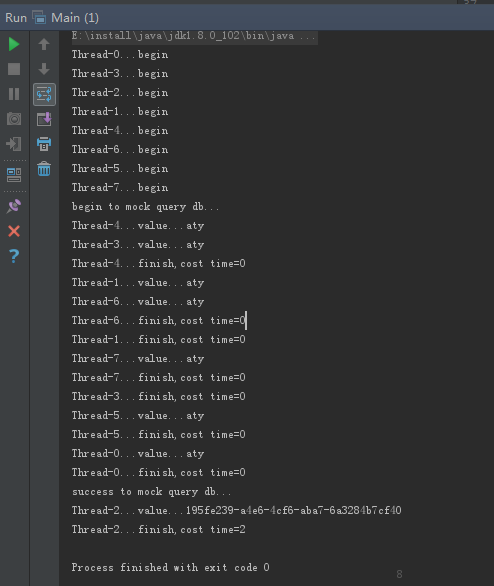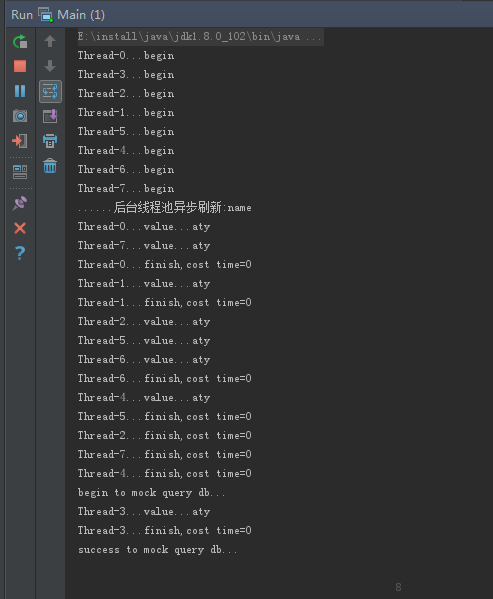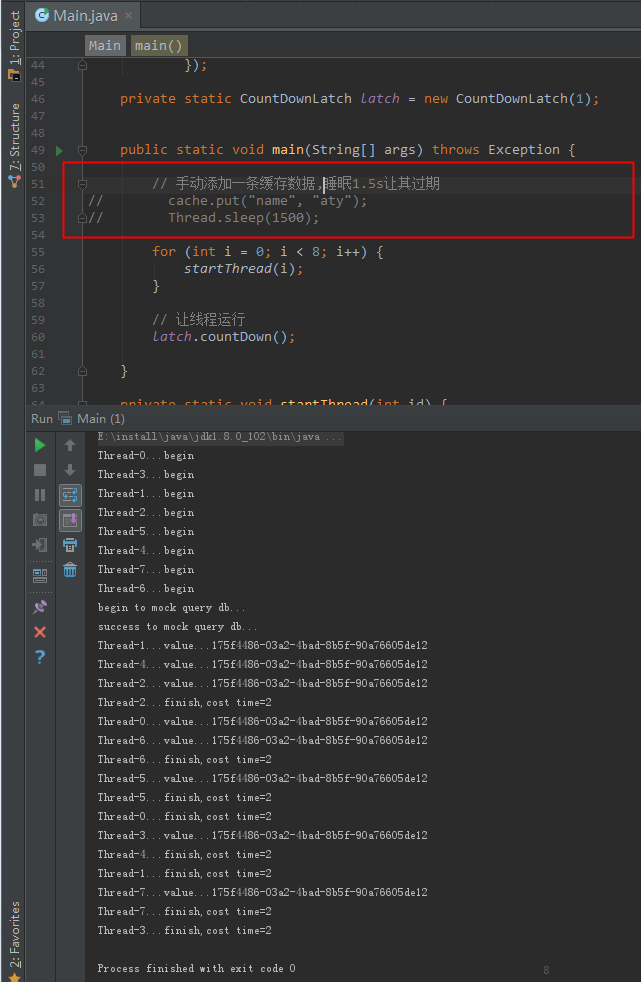Guava Cache特性:refreshAfterWrite只阻塞回源執行緒,其他執行緒返回舊值
阿新 • • 發佈:2019-02-18
上一篇文章"Guava Cache特性:對於同一個key,只讓一個請求回源load資料,其他執行緒阻塞等待結果"提到:如果快取過期,恰好有多個執行緒讀取同一個key的值,那麼guava只允許一個執行緒去載入資料,其餘執行緒阻塞。這雖然可以防止大量請求穿透快取,但是效率低下。使用refreshAfterWrite可以做到:只阻塞載入資料的執行緒,其餘執行緒返回舊資料。
package net.aty.guava; import com.google.common.base.Stopwatch; import com.google.common.cache.CacheBuilder; import com.google.common.cache.CacheLoader; import com.google.common.cache.LoadingCache; import java.util.UUID; import java.util.concurrent.Callable; import java.util.concurrent.CountDownLatch; import java.util.concurrent.TimeUnit; public class Main { // 模擬一個需要耗時2s的資料庫查詢任務 private static Callable<String> callable = new Callable<String>() { @Override public String call() throws Exception { System.out.println("begin to mock query db..."); Thread.sleep(2000); System.out.println("success to mock query db..."); return UUID.randomUUID().toString(); } }; // 1s後重新整理快取 private static LoadingCache<String, String> cache = CacheBuilder.newBuilder().refreshAfterWrite(1, TimeUnit.SECONDS) .build(new CacheLoader<String, String>() { @Override public String load(String key) throws Exception { return callable.call(); } }); private static CountDownLatch latch = new CountDownLatch(1); public static void main(String[] args) throws Exception { // 手動新增一條快取資料,睡眠1.5s讓其過期 cache.put("name", "aty"); Thread.sleep(1500); for (int i = 0; i < 8; i++) { startThread(i); } // 讓執行緒執行 latch.countDown(); } private static void startThread(int id) { Thread t = new Thread(new Runnable() { @Override public void run() { try { System.out.println(Thread.currentThread().getName() + "...begin"); latch.await(); Stopwatch watch = Stopwatch.createStarted(); System.out.println(Thread.currentThread().getName() + "...value..." + cache.get("name")); watch.stop(); System.out.println(Thread.currentThread().getName() + "...finish,cost time=" + watch.elapsed(TimeUnit.SECONDS)); } catch (Exception e) { e.printStackTrace(); } } }); t.setName("Thread-" + id); t.start(); } }

通過輸出結果可以看出:當快取資料過期的時候,真正去載入資料的執行緒會阻塞一段時間,其餘執行緒立馬返回過期的值,顯然這種處理方式更符合實際的使用場景。
有一點需要注意:我們手動向快取中添加了一條資料,並讓其過期。如果沒有這行程式碼,程式執行結果如下。
由於快取沒有資料,導致一個執行緒去載入資料的時候,別的執行緒都阻塞了(因為沒有舊值可以返回)。所以一般系統啟動的時候,我們需要將資料預先載入到快取,不然就會出現這種情況。
還有一個問題不爽:真正載入資料的那個執行緒一定會阻塞,我們希望這個載入過程是非同步的。這樣就可以讓所有執行緒立馬返回舊值,在後臺重新整理快取資料。refreshAfterWrite預設的重新整理是同步的,會在呼叫者的執行緒中執行。我們可以改造成非同步的,實現CacheLoader.reload()。
package net.aty.guava; import com.google.common.base.Stopwatch; import com.google.common.cache.CacheBuilder; import com.google.common.cache.CacheLoader; import com.google.common.cache.LoadingCache; import com.google.common.util.concurrent.ListenableFuture; import com.google.common.util.concurrent.ListeningExecutorService; import com.google.common.util.concurrent.MoreExecutors; import java.util.UUID; import java.util.concurrent.Callable; import java.util.concurrent.CountDownLatch; import java.util.concurrent.Executors; import java.util.concurrent.TimeUnit; public class Main { // 模擬一個需要耗時2s的資料庫查詢任務 private static Callable<String> callable = new Callable<String>() { @Override public String call() throws Exception { System.out.println("begin to mock query db..."); Thread.sleep(2000); System.out.println("success to mock query db..."); return UUID.randomUUID().toString(); } }; // guava執行緒池,用來產生ListenableFuture private static ListeningExecutorService service = MoreExecutors.listeningDecorator(Executors.newFixedThreadPool(10)); private static LoadingCache<String, String> cache = CacheBuilder.newBuilder().refreshAfterWrite(1, TimeUnit.SECONDS) .build(new CacheLoader<String, String>() { @Override public String load(String key) throws Exception { return callable.call(); } @Override public ListenableFuture<String> reload(String key, String oldValue) throws Exception { System.out.println("......後臺執行緒池非同步重新整理:" + key); return service.submit(callable); } }); private static CountDownLatch latch = new CountDownLatch(1); public static void main(String[] args) throws Exception { cache.put("name", "aty"); Thread.sleep(1500); for (int i = 0; i < 8; i++) { startThread(i); } // 讓執行緒執行 latch.countDown(); } private static void startThread(int id) { Thread t = new Thread(new Runnable() { @Override public void run() { try { System.out.println(Thread.currentThread().getName() + "...begin"); latch.await(); Stopwatch watch = Stopwatch.createStarted(); System.out.println(Thread.currentThread().getName() + "...value..." + cache.get("name")); watch.stop(); System.out.println(Thread.currentThread().getName() + "...finish,cost time=" + watch.elapsed(TimeUnit.SECONDS)); } catch (Exception e) { e.printStackTrace(); } } }); t.setName("Thread-" + id); t.start(); } }


